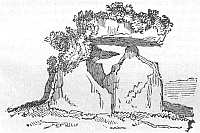Cromleach, (or Cromlech) at Knockeen, County of Waterford
From The Dublin Penny Journal, Volume 1, Number 31, January 26, 1833
The annexed cut is a faithful representation of a CROMLEACH at a place called Knockeen, about five miles north of the celebrated watering-place, Tramore, in the County of Waterford. I should more properly have written that my drawing correctly represents what that Druidical monument was in the year 1825, because I cannot say what damage it may have since received, as I have not seen it for the last seven years.
 The word Cromleach is from the Irish, Cromleac
a pagan altar, which is a compound of Crom,
God, and leac,
a flat stone. The one now about to be described is situate on the
gentle declivity of a small hill, as the name of the place, Knockeen,
i. e. "the little hill," indicates, and was constructed of eight huge
rocks, six of which stood upright, and the remaining two were laid flat
upon some of the erect ones. One of the latter stones, which is about
sixteen feet in length, and of proportionate breadth and thickness,
weighing five or six tons, appears to have been balanced on the top of
one of the upright rocks, as on a pivot. At the time I saw it, one end
of this stupendous block seemed to be suspended in the air, but the
other end was overgrown with ivy, which connected it with the stones
beneath, and gave the whole group a very fantastic and grotesque
effect. It is to be remarked that this structure lay due east and west,
in conformity with the ancient custom, which assigned amongst the
cardinal points a religious pre-eminence to the east. This superiority
of the east over the other points of the compass in religious worship
at the first glance strikes one as strange, nay, almost, as pagan and
ridiculous, but many important reasons for its continuance are to be
found in an anonymous work, entitled "The Picture of Parsonstown,"
published by subscription in 1826.
The author of that work, in describing the new Roman Catholic Chapel of
Parsonstown, animadverts on the position in which that edifice was
placed, and quotes from scripture, the primitive fathers, and profane
writers, a great number of curious and interesting authorities on the
subject.
The word Cromleach is from the Irish, Cromleac
a pagan altar, which is a compound of Crom,
God, and leac,
a flat stone. The one now about to be described is situate on the
gentle declivity of a small hill, as the name of the place, Knockeen,
i. e. "the little hill," indicates, and was constructed of eight huge
rocks, six of which stood upright, and the remaining two were laid flat
upon some of the erect ones. One of the latter stones, which is about
sixteen feet in length, and of proportionate breadth and thickness,
weighing five or six tons, appears to have been balanced on the top of
one of the upright rocks, as on a pivot. At the time I saw it, one end
of this stupendous block seemed to be suspended in the air, but the
other end was overgrown with ivy, which connected it with the stones
beneath, and gave the whole group a very fantastic and grotesque
effect. It is to be remarked that this structure lay due east and west,
in conformity with the ancient custom, which assigned amongst the
cardinal points a religious pre-eminence to the east. This superiority
of the east over the other points of the compass in religious worship
at the first glance strikes one as strange, nay, almost, as pagan and
ridiculous, but many important reasons for its continuance are to be
found in an anonymous work, entitled "The Picture of Parsonstown,"
published by subscription in 1826.
The author of that work, in describing the new Roman Catholic Chapel of
Parsonstown, animadverts on the position in which that edifice was
placed, and quotes from scripture, the primitive fathers, and profane
writers, a great number of curious and interesting authorities on the
subject.
In proof that the early preachers of Christianity were unwilling to divert their converts from those places of worship which they had while pagans been accustomed to resort to, in order thereby the more readily to win their attendance at their new devotions, we find mouldering in decay, within twenty yards of this Cromleach, the more modern yet venerable ruins of a Christian Church, and there also is to be seen a burial ground adjoining. A countryman I happened to meet on the spot, informed me that hard-by was one of those subterranean dwellings which were inhabited by the ancient Druids, and which are so often to be read of in Irish history. However, at the time of my visit the entrance to this cave, unfortunately for me, was closed up.
There cannot be a doubt but that the huge stones now being written of served formerly as an altar for sacrifice The kind of altars which, Wormius informs us, were used by the northern nations and Cimbri, is similar to that just described. This amazing pile of ponderous granite presents a specimen of the Rocking-stones or Baetylia, (i. e. moving or animated stones) which the late learned Dr. Lanigan finds fault with Bochart for calling anointed stones, although perhaps either epithet is equally appropriate. It is worthy of note that Dr. Smith, notwithstanding his acknowledged research, industry, and learning, has omitted to notice this Cromleach at Knockeen in his able and laborious work on the County of Waterford.
B.
